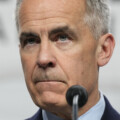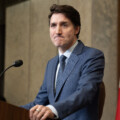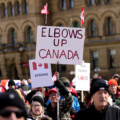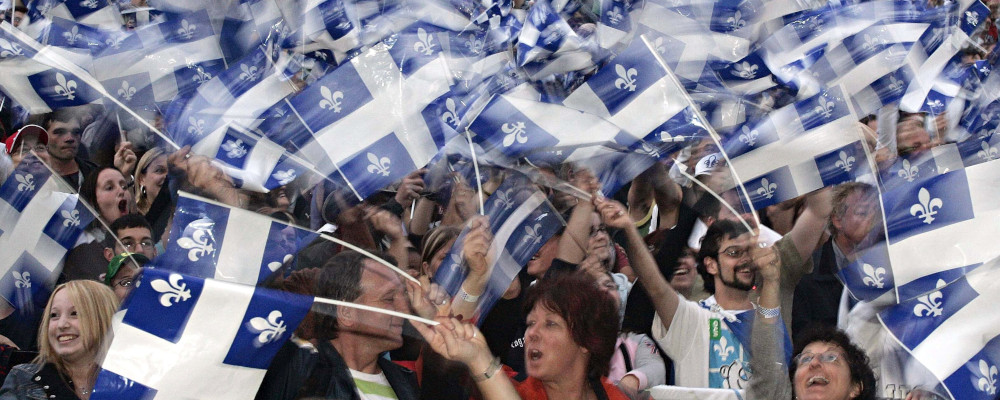Part II:
Part I began to explore the distinction between a nation and a province in response to Saskatchewan’s recent white paper “Drawing the Line.” This Part II provides an answer to why the Québécois are a nation, and why Saskatchewan isn’t. Part III will explain why the distinction shouldn’t matter for the proper working of Canadian federalism.
“Drawing the Line,” the recently-published white paper by the Government of Saskatchewan that advocates a more aggressive assertion of provincial autonomy, repeats Premier Scott Moe’s statement last year that “Saskatchewan needs to be a nation within a nation.” It’s a curious inclusion. Why is it not enough to demand more power for the province qua province? Why introduce the sticky subject of nationality and nationhood? It must be because a nation is something more than a province (or a country), and the government thinks that whatever this is adds to its constitutional claim. It is right on the first point, but not on the second.
The claim that Saskatchewan needs to be “a nation within a nation” asks implicitly why we recognize the Québécois (or Quebec) as a nation and not Saskatchewan. It is an important question, though not a particularly difficult one. The answer is that there is something about the way the Québécois are different from other Canadians that transcends the ways in which the people of the other provinces are different from each other. In the case of Quebec, those ways are clear. You don’t even have to accept the continuing relevance of the idea of Two Founding PeoplesOr “two founding races,” to use the old and now unfashionable term. See, eg, Mr Pearson’s 1963 Royal Commission on Bilingualism and Biculturalism, which was to “inquire and report upon the existing state of bilingualism and biculturalism in Canada and to recommend what steps should be taken to develop the Canadian Confederation on the basis of an equal partnership between the two founding races, taking into account the contribution made by the other ethnic groups to the cultural enrichment of Canada.” to recognize that the Québécois (and, for that matter, Quebec) are uniquely distinct within Canada.
The claim that the Québécois have a qualitatively distinct culture (or that Quebec forms a distinct society) worthy of “national” status is inextricable from the fact of the French language. Charles Taylor has written extensively about how, in our post-Romantic world, the need for identity (and, importantly, recognition of one’s identity) is also a project of emancipation.See, eg Charles Taylor, Why Do Nations Have to Become States?, in Stanley French (ed), Philosophers Look at Canadian Confederation (1979). Writing about Quebec specifically, he has explained that “the singling out of linguistic nationality as the paradigm pole of self-identity is part of this modern drive to emancipation.”id. There is simply no comparable drive for generative self-creation in any other province.
But if the most obvious difference is linguistic, the differences aren’t only linguistic.At least since the 1960s, the Government of Quebec has claimed to be the political expression of a Québécois nation but it doesn’t seek to include Franco-Ontarians or New Brunswick Acadians within the definition of “Québécois” or to expand the borders of Quebec to include these contiguous people, which would be logical if the identity were purely linguistic. This is a consequence of the separatist movement’s recognition that the French language and a distinct culture were best defended by a political entity that was majority French Canadian. Hence the definition of the Québécois in geographic terms as well as along cultural (and, usually, linguistic) lines. René Lévesque even went so far as to label French Canadians outside the province “dead ducks.” By contrast, Pierre Trudeau insisted that “the Quebec Legislature has no authority to speak on behalf of ‘French Canada’” because of the reality of non-Quebec French-Canada, though even he accepted that “because of historical circumstances Quebec has had to, and must still, assume responsibility for the French language and culture.” While the French language is the central feature of Québécois nationalism, the fact that some provincial residents included among “the Québécois” speak French imperfectly and others not all, while other people just across the Ottawa and Restigouche rivers who speak fluent French are not included within the nation, means that there must be a component of national identity beyond language. For want of a more precise term, this extra-linguistic component of identity is culture, and specifically “culture” in a deep sense that goes beyond what we mean when we talk about the culture of Calgary being different from the culture of Edmonton.
For culture to be a definitive component of national identity, it must be rooted in and reinforced by factors that are separate not just in degree but in kind from anything experienced in other parts of the country. Where, then, does Québécois culture come from? Once again, linguistic difference matters. The idea that the language we speak influences the way we think is not new. It is likely that simply by dint of speaking (and thinking in) another language, a people develop a distinct culture. The predominantly French-speaking parts of Canada can be said then to have a separate culture in a way that no predominantly English-speaking region can.
Nor should we underestimate the effects of the closed media environment that this linguistic separateness requires. More than any other region, Quebec speaks to itself. Most Québécois consume news of the rest of the country second-hand, only after it has been translated both literally and culturally by the province’s media. This linguistic isolation appears to be self-reinforcing: small differences are exaggerated, while large differences are entrenched as cultural and political dogma.
But language is only part of the story. The other source of Quebec’s cultural difference is religious. This was clear for the first half of Canadian history when the province stood out as a distinct Catholic society within an increasingly-Protestant Canada. The revolutionary rejection of the province’s Catholic identity in the last three generations means that the weight of cultural identity that once rested on three pillars—language, culture, and religion—is now borne by language and culture alone, which increases concern about linguistic survival and awareness of cultural differences.
More importantly, it means that Quebec’s attitude towards religion is, uniquely within Canada, defined by a conscious rejection of religion. In a relatively short time, a profoundly Catholic society became radically anti-clerical. Nothing like that happened in any other province. As Marshall McLuhan described it (in his strange review of Pierre Trudeau’s 1967 collection of essays Federalism and the French Canadians for the New York Times), “French Canada leapt into the 20th century without having had a 19th century.” This is an exaggeration, but only a slight one, and the legacy of this sudden leap can be puzzling to non-Quebeckers.The speed of the Quiet Revolution is captured in a poignant scene from Denys Arcand’s Les Invasions Barbares in which a priest showing an auction-house rep around a warehouse of surplus Catholic statuary explains how one day in 1966 everyone stopped coming to church and never came back.
To an outsider, Quebec’s insistence on militant laïcité as a distinct cultural value is more than a little ironic. Secularism emphatically is not a traditional Quebec value, as the illuminated cross on Mount Royal shining down a forest of silver spires across the city of Montreal attests.The cross, which is a reminder of the original cross erected by Paul Chomedey de Maisonneuve in 1643, was installed in 1924 by the Société Saint-Jean-Baptiste. It is lit in purple to mark the death of a Pope. Within the lifetime of the current premier, the province’s hospitals, schools, and houses of charity were still staffed in part by priests and nuns, whose prominent religious symbols and head coverings were an obvious example of Quebec’s distinct society. And the province remains dappled with the memory of its first four centuries. From riversThe St Lawrence river. and lakes,Lac Saint-Jean. townsSaint-Jean-sur-Richelieu. and mountains,The Notre Dame Mountains. hospitals,In Quebec City alone, there are hospitals named: Hôpital Saint-François d’Assise; Hôpital de l’Enfant-Jésus; Hôpital du Saint-Sacrement; and Hôtel-Dieu de Québec. universities,Université Laval (the successor to the Séminaire de Québec, now named after the first bishop of New France). and metro stations,Metro Pie IX; Metro Lionel-Groulx. the province’s traditional identity suffuses the landscape.
Pointing this out, however, invites the accusation that, as a non-Quebecker, you simply can’t understand the continuing legacy of La Grande Noirceur. This is of course true, but it also illustrates how quickly even a recent mythopoeic change can assume mythic cultural status. Until the 1950s, the Government of Quebec unofficially regarded the post-revolutionary government of France as a usurping regime. Then, in the space of a decade, the province’s leadership traded a historic domestic identity for one based on the secularist ideology of a foreign country.For an English perspective on this process, see Charles Taylor, “Nationalism and the Political Intelligentsia: A Case Study,” Queen’s Quarterly (Spring 1965). One has to admit that the transplant has been successful: imported by a small class of Quebec intellectuals, the fashions of post-war Parisian philosophy have been adopted so completely in Quebec that it is now hard to tell the graft from the rootstock.One can imagine an alternative history in which Quebec remained Catholic and defended its traditional religious-cultural identity against claims by competing religions instead of policing them as a violation of a newly-adopted secular cultural identity (with possible exceptions for religious symbols and references magically denuded of their religious content and existing now as purely “historical” objects and customs). It could be argued that this reactionary path would have been more consistent and coherent. However, Charles Taylor was probably right when he wrote that “the context of a federal Canada would never permit a Quebec leader” to repress democracy enough to allow Quebec to follow the contemporary example of Salazar’s Portugal. See Charles Taylor, “Nationalism and the Political Intelligentsia: A Case Study”, Queen’s Quarterly (Spring 1965).
These distinct features of Quebec society—linguistic (by birth) and cultural (by adoption)—are real. Together they make the Québécois, by any normal definition, a nation. The belated recognition of this by the federal parliament in 2006 was just an acceptance of reality. By the same token, Saskatchewan is not a nation. Saskatchewan is certainly different from, say, Ontario, and both are different in their own ways from British Columbia and Newfoundland.Years ago, Charles Taylor wrote that “for all people east of the Rocky Mountains, British Columbia is a strange place, not quite believable,” and yet even he didn’t believe this grounded a claim for nationhood. Charles Taylor, “A Canadian Future?”, in The Pattern of Politics (1970). Nobody would deny that. But they are each different within the normal parameters of difference for a vast and diffuse country. It makes no more sense to say that Saskatchewan is a nation than to imagine that Wyoming is a nation within the United States of America.
Recommended for You

Laura David: Red pill, blue pill: Google has made its opening salvo in the AI-news war. What’s Canadian media’s next move?

The Notebook by Theo Argitis: Mark Carney’s first major tests

The Weekly Wrap: Trudeau left Canada in terrible fiscal shape—and now Carney’s on clean-up duty

Ben Woodfinden: Lament for an ‘elbows up’ nation




